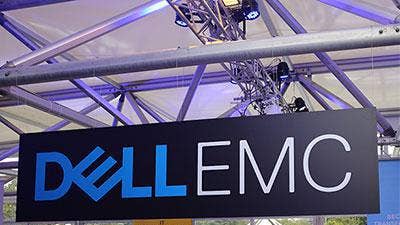The 10 Biggest Enterprise Data Storage Industry Predictions For 2019

Capabilities, Not Specific Vendors, Will Determine How Data Is Managed
While storage speeds and feeds is still a way for vendors to differentiate themselves, it is no longer what customers want to hear about. Instead, businesses are demanding certain capabilities, and are willing to go outside their traditional vendor comfort zone to get them.
While this concept is already a common thread in storage conversations across the industry, it will take on new importance in 2019 as providers of storage technology, both on-premises and cloud, look for new ways to ease the management, protection, and monetization of data.
On-prem or cloud? Yes. Brand A or Brand B? Yes. These questions in 2019 will be increasingly irrelevant as technologies such as software-defined storage and multi-cloud management come to the fore.
CRN looks at 10 areas where enterprise and midrange storage management will change in 2019.

Software-defined Storage Starts Its Industry Take-over
What is a storage array? In essence, it's an industry-standard server on which software that manages data and provides storage services runs. Yes, they are integrated, and the hardware may be optimized somewhat for the software. But for the most part, take away the software, and you have another server.
But take away the hardware, and you have software that in all likelihood will provide needed storage services on any server, or on a virtual server, or on a cloud. This software-defined storage will play an increasingly prominent role in the storage industry in 2019. We've already seen companies like NetApp make its storage OS available to run natively on the cloud, and Needham, Mass.-based all-flash array vendor Kaminario in 2018 got rid of its hardware entirely. Expect the uptake of software-defined storage in 2019 to move faster than in the past as vendors explore ways to make the integration and optimization of the software with customers' own server hardware faster and easier.

Dell EMC Will Consolidate
Making a prediction about a particular company is risky, but this is one instance where the risk is rather low.
Dell EMC in 2019 will finally consolidate its multitude of midrange storage lines (think Unity, Compellent SC series, EqualLogic PS series) into a single midrange storage line, with possibly part of its PowerMax line thrown in for good measure. Multiple storage acquisitions over the years has placed Dell EMC in a storage Catch-22: Do you keep multiple lines to support existing customers of those lines despite the cost of doing so, or do you go for efficiency at the risk of alienating some of that customer base?
The consolidation of its storage lines is risky given that it presents an opportunity for customers to look at competing vendors at the same time. But it will be a very important move for Dell EMC as it looks to the future of the storage industry.

Brand Loyalty Will Fade
Storage vendors have gotten very good at the technology they produce. And at the same time, cloud storage providers have gotten very good at what they do.
That will make 2019 a year when brand loyalty takes a hit primarily because storage sales is no longer about speeds and feeds. Customers really don't care that Brand A's NVMe-based storage array is faster than Brand B's NVMe-based storage array. Heck, cost isn't even that much a factor. The really important sales point going forward is not how good the technology is, but how well does the technology fit customers' specific requirements. This is what makes the channel shine, as astute sales reps make sure they understand customers' requirements even better than customers understand their own requirements, and tailor the solution to those needs regardless of who develops the technology. Customers won't buy Brand A because it's Brand A, but because it provides the right combination of performance, cloud connectivity, storage services, and price.

Barriers Between On-prem And Cloud Will Fall
All data is not equal. Some need extreme performance that can only be done on-premises with flash arrays. Other data can be moved to tape or cloud where it may never be accessed again except in rare cases. But in between is a lot of data where the location is not an issue, and which increasingly needs to be migrated between locations to meet customers' requirements. And that includes migrating between on-premises and one or more clouds.
A couple of storage vendors have started making seamless migration of data back and forth between on-prem and cloud infrastructures possible. Of the top storage vendors, NetApp seems to be in the lead, while Pure Storage in 2018 jumped toward the head of the pack. For 2019, expect all or nearly all the top storage vendors to introduce native and transparent migration of data between on-prem and multiple clouds. They know that the cloud is an integral part of customers' data storage plans, and that not fully embracing the cloud could cost market share.

AI To The Fore
One huge promise of artificial intelligence is the ability for technology to take over routine tasks, freeing up real people to do more specialized operations or focus more on revenue-building processes. Storage and data management, monitoring storage processes, and migration of data to ensure optimized performance and protection are prime candidates for artificial intelligence.
A few vendors have moved in this direction, with HPE taking advantage of the InfoSight AI-based management technology from its Nimble Storage acquisition to be a leader in this space. Expect all, or nearly all, storage vendors to make strong moves in this area in 2019.
Also expect a couple of storage vendors to start using AI to not only find issues, but to automatically remedy them. This is a tricky part of AI, given that customers will have to trust the software can take action independently of human administrators. So this will be a long-term process. But it's starting.

Data Unites
Primary data? Secondary data? Archive data? How many copies of data does one company need? How many, when the typical company probably cannot guess how much data it is currently storing.
Eliminating multiple copies of data, and focusing management on one, or maybe two, copies is key to lowering the cost of storage and its management. A couple of smaller vendors have started moving in this direction, but it has yet to see broad availability. Expect that to change in 2019 as more storage vendors bring out this capability.
Yes, storage vendors would prefer customers keep as many copies of data as possible on their arrays. But they realize that, if they don't get in front of the issue, a competitor will get in front of them.

Petabyte-scale Takes Over
No one denies that the amount of data being stored is continuing to grow. However, many businesses are in denial about how much their data is growing. Petabyte-scale storage has been a part of the enterprise infrastructure planning process for some time, but it’s an issue that midsize businesses in 2019 will have to be increasingly aware of. Customer data, supplier data, and internal operations and financial data is growing, to be sure. But data from such sources as IT management and monitoring, edge devices, video surveillance requires new ways of management. Businesses that have not yet invested in processes to manage this fast-growing data risk losing control of it.

New Data Privacy Challenges
By now, nearly everyone has heard of GDPR, or General Data Protection Regulation, a new European Union law that mandates protection of EU individuals' privacy, and provides stiff fines when such data is leaked or hacked. But not all U.S.-based businesses realize that they are just as liable as a European company for GDPR issues should they be storing data on EU citizens.
This will grow increasing complicated. California recently passed its own data privacy protection regulations, and given the size of California and its market, this is a law that will have a ripple effect across the country. Other countries such as Japan are also moving in this direction. 2019 will be the year in which businesses finally realize that it is cheaper to make protection of data privacy a priority than it is to deal with the aftermath of data loss.

Data Lakes Will Drain
The last couple years have seen the rise in data lakes, which are repositories of raw data that are stored in native format, usually as objects or files, until it is needed. However, merely storing that data is no longer good enough, or even desirable. Much of that data has value that can be monetized, and will be monetized for management, marketing, process operation, and other purposes, typically with big data tools like Hadoop. But the rest? That which cannot be used for business purposes needs to be pushed out of the pool, or better yet not be collected at all. Artificial intelligence and other tools will automate the process of determining what data can be kept and for how long, and will start becoming more of a priority in 2019.

Multi-cloud Management Will Rule
Managing data on a cloud is relatively easy with tools provided by the cloud provider or third parties. But managing data across two or more clouds is much, much more difficult given that each cloud provider has its own formats and, more importantly, its own rules and cost structures designed to make moving data into its cloud much more easy than moving it out.
Businesses, however, want to make it easy to move data into and out of any cloud they choose. They may want to take advantage of cost differences, or different capabilities including compute, or changes in business operations. A couple of storage vendors are talking about multi-cloud management. But 2019 will see the storage industry as a whole embrace the concept in response to customer requirements.